
(Photos © M.Andersen/BikePortland)
Some cargo bikes, built for personal freight and boxes, are low and light. Others, built for kids and errands, are deep and sturdy.
The cargo bike Neal Saiki is about to bring to market has a new formula. It’s built to operate at the height that most of the world’s work actually gets done: approximately three feet in the air.
But for the 2×4 cargo e-bike, which Saiki showed off in Portland this week, a waist-high cargo bed is just the beginning.
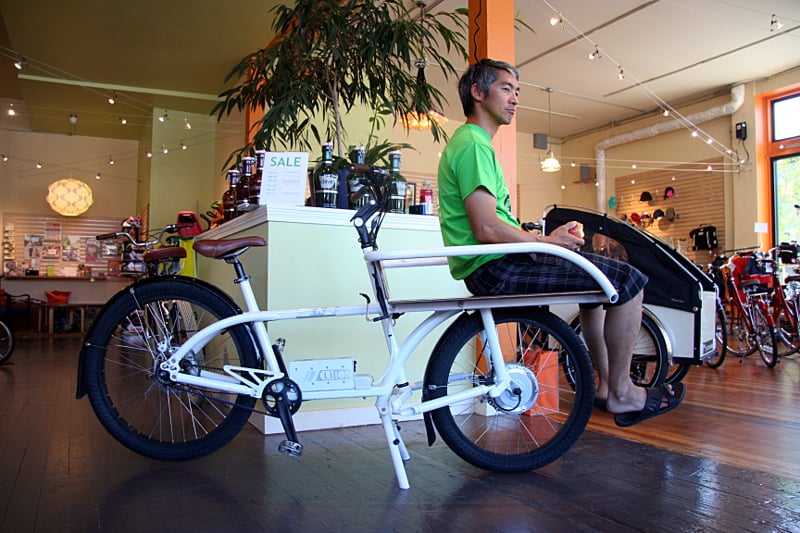
creator’s full weight just fine while parked at Clever Cycles Tuesday.
Saiki, a 27-year veteran of the bike building industry who’s specialized in electric vehicles since 2004, launched his latest creation last week with a very specific market in mind: European postal carriers.
“They need to have the letters in front of them because they need to sort them,” explained Saiki, who is based in Santa Cruz, Calif. The high bed means that workers don’t need to repeatedly bend over, potentially hurting their backs, to fetch the cargo.
Saiki and his wife and business partner, Lisa Saiki, took their prototype to the Eurobike trade show last week and drew interest from the Belgian, German and Swiss post offices, all of which are considering replacing fully motorized vehicles with partially human-powered ones. But they’re also targeting local delivery companies, nongovernmental aid organizations working in remote areas, and individual consumers.
This is an industrial-quality vehicle with a cost to match: The 68-pound 2×4 will retail for $4,600. Saiki said Tuesday that he expects “100 to 200 bikes to be ready around January to February.”
I got to take a close look at the new contraption. Let’s take the features one by one.
Battery. “The battery has been the problem for all of these electric vehicles,” Saiki said, citing the risk of unreliability or malfunction. Informed by Saiki’s work at his last startup, electric vehicle company Zero Motorcycles, Saiki chose a new Samsung variety that he called “the first completely safe lithium ion battery.” “You can overcharge it, you can put it in an oven, you can crush it and you can pierce it with a steel rod,” he said. NTS says it’s good for 500 to 1000 full recharges and can help you move 10,000 miles for a cost of about $30.
The company offers a lifetime service warranty and will swap in a new battery at any time for half the cost of a new battery (the new price is currently listed at $900). The water-sealed battery is modular, so welding isn’t necessary for service.
Electric assist. Most e-bikes put their electric drive at the back wheel. In order to let the 2×4 easily haul hundreds of pounds up steps and over uneven surfaces, it assist works at the front hub, giving the vehicle the delicate feeling of a power steering car.
Throttle control. The motor is activated by pedaling, and shuts off automatically after a hand brake or two seconds of inactivity. However, a simple panel on the left handlebar lets you boost, increase or decrease power manually: “Push the button to climb any curb,” Saiki says. The 2×4’s 250-watt engine will assist you up to 20 mph.
Wheels. The 2×4 is built for 300-year-old curbs and cobblestones: It has two large wheels, a 50.4″ wheelbase and the fattest tires I’d ever seen on a bike. Relying on two wheels, instead of three, is another advantage when cornering and taking curbs in an urban environment:
Kickstand. Saiki describes himself as a “kickstand maniac,” and this one struck me as being designed with particular care. Each hollow tube in the kickstand folds independently, with sealed cartridge bearings and a springy thunk into place when it’s down. To fold it back up, you can just get on and start pedaling.
Mirror. A wide, curving, adjustable rear-view mirror is affixed not to the handlebars but to the frame itself.
Drive belt. “I personally don’t like maintenance,” Saiki said. “Our goal is just to make a bike that you never think about.” The carbon Gates center track belt drive, which connects to an 8-gear hub on the back wheel, doesn’t require oil and doesn’t acquire much grit on the road. Saiki rubbed his hand across the belt that he said he’d ridden 1,000 miles on, showing that it wasn’t leaving a mark on his skin.
The bike’s unusual characteristics — minimal maintenance, relatively few moving parts, maximal adaptability to terrain — are intended to add up to a vehicle with day-after-day reliability and effortless utility.
“This is like buying a 1940s Cadillac,” Saiki said. “These things last forever.”
They’ll be sold directly on the NTS website and may also be available via local cargo-bike specialists like Clever Cycles and Splendid Cycles; call for availability once the bikes are in production next year. The Saikis start the second stop of their U.S. launch tour, Seattle, today.



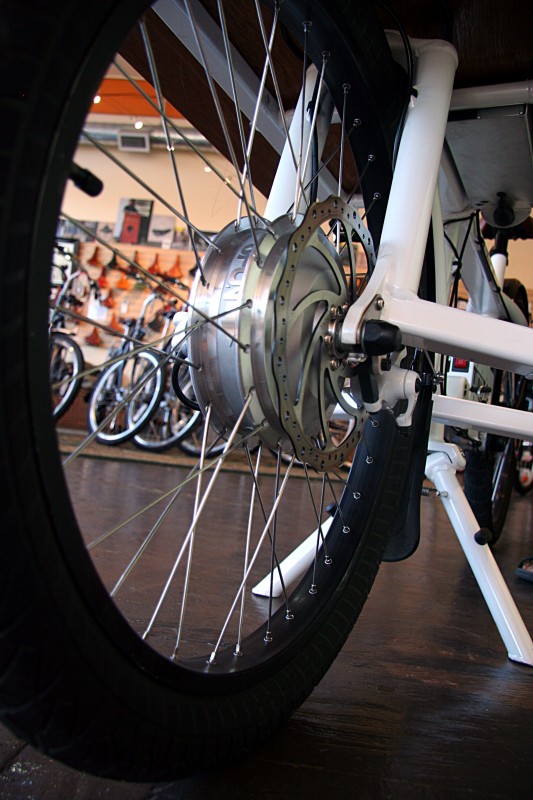
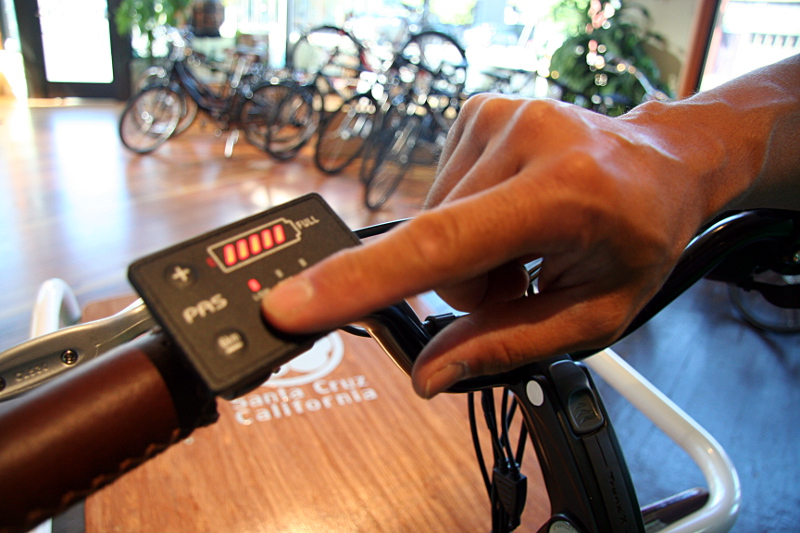

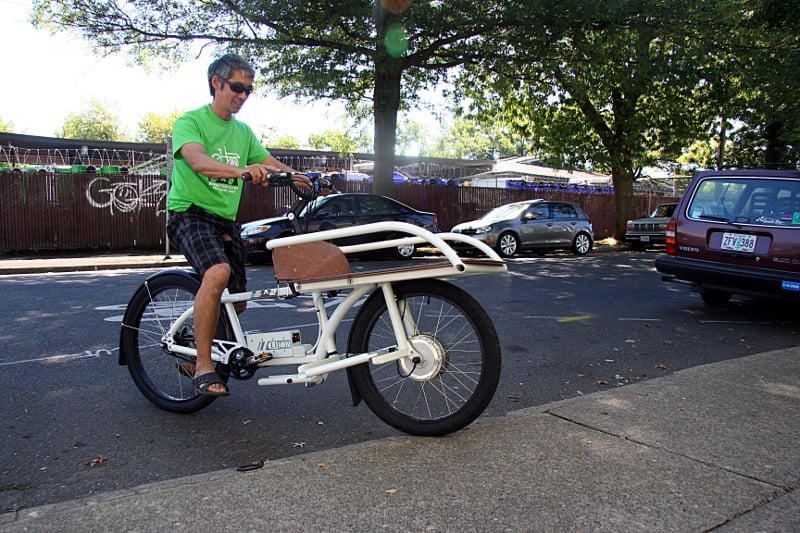
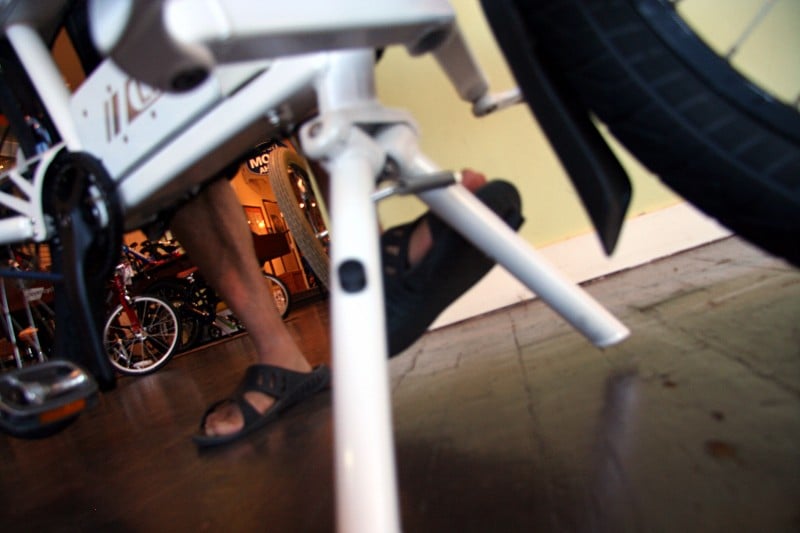




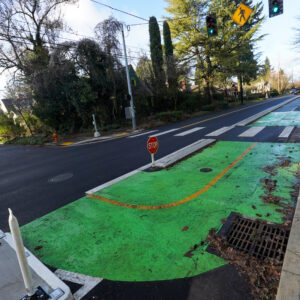
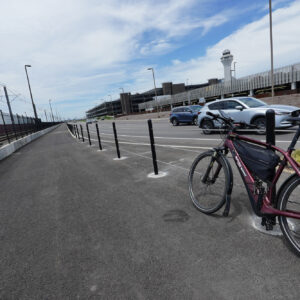

Thanks for reading.
BikePortland has served this community with independent community journalism since 2005. We rely on subscriptions from readers like you to survive. Your financial support is vital in keeping this valuable resource alive and well.
Please subscribe today to strengthen and expand our work.
“drew interest from the Belgian, German and Swiss post offices, all of which are considering replacing fully motorized vehicles with partially human-powered ones.”
Writing on wall. The future is human powered. And the past isn’t half as scary as we here in the US sometimes think it is.
http://www.flickr.com/photos/schockwellenreiter/2385910136/in/photostream/
Neat bike, by the way. Thanks for the profile.
Who knows, maybe the USA is positioned to make sure the best cargo ebike for European users.
Certainly China will make a cheaper product and European designers are quite capable of quality equal to our own but America offers a lower manufacturing cost than Europe with equivalent quality and an insane need to innovate.
I would note that the German Post company (Deutsche Post) actually already does have an e-bike that they use in many cities. While this might be more flexible, the bikes they use appear custom made for the bins that they have. http://www.flickr.com/photos/santoshpm/4351414746/
The batteries are the swappable units in the back, and it is also powered by a front hub motor and has a great wide, rolling kickstand.
This new cargo bike is a very cool design, but already has some custom-made competition.
Also, tangentially – Deutsche Post employees are not required to wear helmets.
more fun:
http://forum.postmoped.de/viewtopic.php?f=10&t=70
http://img442.imageshack.us/img442/1876/ae3zn2.jpg
Looks really cool! Yes 9 Watts! The future is human powered! Often wonder how cool it would be to see city of Portland workers with “The City that works” motto on cargobikes with that sign on the bike! I have also looked at the mail loads in USPS minivans, and thought that it could be done with a bike and trailer.
Yep. Instead of buying SMART cars or Nissan Leafs or whatever the automotive fad of the day suggests, our City’s purchasing division could start buying some of Bill Stites’ Truck Trikes (made here in Portland) or something similar, and we’d be a lot better prepared for plausible futures, healthier, more vibrant. I think the PR motivation that seems to underlie the purchase of these vanity cars would be even better served by going this route.
I’d love to see some of these rigged specifically as ambulances.
For the human-powered ambulance version I think a suitably configured trailer is the way to go.
When time to medical facility is a major factor in survival, a human powered ambulance does not make sense.
The patient requires an attendant be at their side monitoring vital signs and administering care throughout the trip.
How many people do you think would be needed to transport the trailer carrying a patient, an EMT and equipment?
Human powered transport is viable, but as an ambulance it a major fail.
“The patient requires an attendant be at their side monitoring vital signs and administering care throughout the trip.”
Right. But if we can’t offer this level of service one day, refusing to look into human powered (not quite perfect) alternatives seems foolish. We did manage as a society for millennia without the kind of ambulances you think are necessary. It is even possible that folks were on balance healthier, needed fewer ambulance rides, before fossil fuels. Who knows, one day (post fossil fuels) hospitals might be less large and far away.
I can’t quite see building a dedicated “ambulance bike” for the US in the next half-century, but it does happen in disasters (like hurricanes, especially) that you obtain both roads that are blocked by fallen trees and landslides for automobile-sized vehicles, and people who have been harmed by the disaster. If you owned a bicycle and a trailer and lived anywhere on the Gulf or Atlantic coasts, it’s something you might keep in the back of your mind. Slowish unattended patient transport is better than no transport at all.
Wow, front-wheel drive, I’d love to try that out and see how it feels. These guys obviously have a ton of experience with building cargo bikes and other 2-wheeled vehicles, but I’m curious about how the high luggage bed affects balance / handling if you load it up. Again, would be interesting to take it for a spin loaded up.
27 years of experience and still looking like a 27 year old!! Another score for bikes.
Not a fan of this design, for several reasons.
There’s zero chance that those controls are going to hold to to sun and water for more than a year. $900 for a battery? Oh wait, you can deprive yourself of your bike for a week and they’ll do it for half price. That box shaped frame is going to wobble like crazy with a load. Speaking of loads, putting the load on the front wheel is suicidal- good luck turning at speed or stopping.
Maybe have a careful look at a someone’s design before you call it suicidal? You don’t seem to understand that the cargo is frame-mounted, not fork-mounted. Big difference.
Hi Annette,
I rode with a load around for about 30 min. and it handles great – and I say that with about 10 years of mom/cargo biking experience!
Doesn’t matter what you say. Annette took a peak at it for 10 seconds and because of her brilliance, she understands all aspects of the bikes kinematics in those 10 seconds. Bow before her insight.
That thing looks great! Kudos.
“It has two full-size wheels” Actually the rear is 26″ and front is 24″
“and the fattest tires I’ve ever seen on a bike” 2.4 is big, but . . .
http://surlybikes.com/bikes/moonlander
Clever has one hanging back towards their service area, actually.
Touche! I’m learning my hardware.
Not quite, but very similar idea…
Yeah, I was gonna say I’ve got a 29×2.5 on the back of my mountain bike and a 29×30.0 on the front right now. And those are nowhere NEAR as fat as tires get these days.
I’d think Surly’s Black Floyd 3.8 tire (without knobby tread) would be better for heavy loading on rough urban surfaces.
Would be interesting to see a non-recreational use for the Moonlander footprint.
I don’t even use a cargo bike but I want one of these!
I think I could get my timid wife to use one of these.
I’ve never wanted a cargo bike (don’t need one), but man. . . this one has me thinking. Well done!
Could I have seen this being test-ridden over in NE near Lloyd Center the other day? It was so striking, and made such a cool little humming sound, that I almost broke my iron-clad introvert rule to shout a question to the rider. Figures I’d find it fully covered here within a day or so! Fantastic new vehicle.
Could Cars2Go or someone add a couple of these to their fleet?
How is the steering different from, say, a LongJohn other than two links instead of one to the bottom of the forks? It’s a more complex mechanism, possibly heavier–is there a payoff?
The first thing that struck me about the steering set-up is the virtual lack of a head tube – there is very little space between the top of the front tire and the cargo area. Normally, there is enough length in the head tube/steer tube to counter to-and-fro forces … but here it looks like the double link arms create a funky parallelogram that supports the fork. If there were only one link arm, there may be too much risk of failure at the joint at the top of the fork … from lightly running into a wall or similar.
I bet they vetted this with engineering analysis – as they appear to have done their homework on this design. I wonder if they could go with one link arm by increasing the diameter of the upper fork joint [think lazy susan].
Overall, very nice design.
Wondering about kid carrying set-ups… you mention kids at the top but don’t really see integrated use?
I didn’t ask specifically about kids but I don’t think this is designed with them in mind — the mention at the top was just intended to refer to bakfiets, the Dutch box bikes that really are good for moving kids.
There’s an optional modification to add low walls to the front cargo bed, but that’s to enable small items, not a small human.
I *did* ask about kids, because that’s kind of my wheelhouse 🙂 — and I also rode the bike with Lisa Saiki in the front. It was no problem, just as easy as my longtail and easier than other front-loaded tricycles I’ve taken out with cargo (though, to be fair, those were heavy loads with no assist). The Saikis themselves use the bike for their kids (they have four) and it seemed very much a marketing decision and not an equipment decision. While this bike would be ideally suited for the sort of parent who wants to make an easy-peasy transition from car to bike mostly for financial and “green” reasons, it doesn’t even seem to be more than a mildly interesting blip on the sales plan for the 2×4. I think if we see parents riding them, they’ll work great, but it won’t be ending up in any company ad copy.
I just remembered I have a photo of Neal on a prototype w/ one of his daughters in front during our July 4 parade.
http://www.flickr.com/photos/99247795@N00/9210335079
Wheelhouse indeed – thanks for weighing in, Sarah.
I met Neal and the 2×4 in Seattle and he said a padded seat that goes on the cargo tray will be available in Europe. I’m assuming it’s harder to get something like that to market here.
I tooled around with the bike empty and on flat streets so I can’t fully speak to its abilities, but it was FUN! Zippy!
The Saikis live down the road from me. I’ve seen Lisa toting their two smaller children around town on front of their 2×4.
Is 250 watts going to be enough? I don’t think that’s enough to be happy-making if you combine big load with steep hill. I’ve done unassisted me + 110lbs on a bike about that heavy up a hill with a peak grade of 10 or 11%, and it was slow and very sweaty.
I imagine a 250 watt assist will be a BIG boost to most average cyclists, even when taking into account bike weight and terrain.
The Saikis live on a road with a 6% grade, and that 250 watt motor provides plenty of oomph to push a load uphill.
It occurs to me that 250W may have more to do with European regulation than anything else, if that is their target market. There are plenty of hills steeper than 6%.
For what it’s worth, I rode this with and without a load and found the handling to be unremarkable in every way, which is perfect. The assist is pretty smooth, unobtrusive, not at all balky like some. I remain skeptical of its ability to get the heaviest loads up the steepest grades, but didn’t get a chance to test this. I was initially put off by the “no passengers” limitation and the somewhat wimpy 100-lb claimed payload, but came away understanding that these are almost entirely driven by liability concerns rather than unambitious engineering. There’s a laser-like focus on the large European postal delivery market, which must make some business sense. They really did their homework on the mess that e-bike batteries are in general: if you think this battery is expensive, try a cheaper one!
I am not the target market (no need for a cargo bike or an electric bike) but somehow I still want this.
Get one and then put it on Spinlist! You’ll make your money back in no time! Um, maybe.
Favorite feature: kickstand. I wish there were a version of that kickstand that would attach to a generic chainstay bridge. I love the way they fold into such a narrow profile. My current cargo bike kickstand can bump certain items of my cargo when I flip it up; this one wouldn’t do that.
I think I’d love this bike in its entirety if I managed a sprawling manufacturing or delivery hub campus.
I like the battery design. The belt drive seems convincing. The bike seems to ride well. Right height to work at — this is important…
But I have watched a lot of Deutsche Post people work on bicycles. They get off and on the bike constantly, taking advantage of the low step over on all the bikes they use and also deploying and un-deploying the front rack – like the massive rack offered on the WorkCycles Fr8 – from the seat of the bike. My guess is that Deutsche Post cyclists and their counterparts in the Netherlands etc. would have an issue with the 2×4 design. Sure, some top brass saw the bikes but the people who will be riding them have to approve — hopefully. And their bikes have mail etc at waist height already.
So both the Bullitt and the 2×4 have aluminium frames AND both don’t have low step over. Without knowing more, I would guess that it is simply difficult to do this with aluminium.
We were forced to have low step over on our trikes because the rear bed / box gets in the way of swinging a leg over the seat from behind – the typical bicycle mounting move.
I’m glad we needed to tackle the issue, as I agree that it’s a real plus for frequent mounting/dismounting. Though low step over does present serious engineering challenges as the loss of the top tube puts a LOT of stress on the solo down tube.
Our frame has a large beam within a monocoque style that resists the added torsion experienced on a non-leaning 3 wheeler. The situation is further aggravated by a fairly high center of gravity of the rider’s body.
We happily work in steel.
Two questions:
How does this handle when stolen, stripped of its expensive components and left in a ditch? There are more poor desperate people every year.
Next, guess what costs $1000, is 4wd, runs on biomass and can sustain speeds of 20 mph for a hundred miles, is not made of earth destructive metals, plastics, polymers or in a sweat shop, goes faster than rush hour traffic in downtown portland , and is not an investment boondoggle? A: A horse. Pull up to Trader Joes on one instead of an SUV momma.
Nice bike but I’m not so sure that ‘waist high’ loading is quite as ‘new’ as the author suggests. The Kemper Filibus has been around for a long, long time as have numerous imitators and similar front-loading bikes. There’s not really that much that’s ever really ‘new’ in bicycles is there…
Savvas.